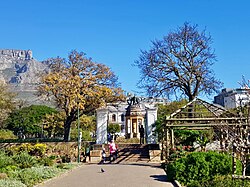History
The Dutch East India Company established the garden in Cape Town for the purpose of providing fresh vegetables to the settlement as well as passing ships. Master gardener and free burgher Hendrik Boom prepared the first ground for sowing of seed on 29 April 1652.
The settlers sowed different kinds of seeds and kept record thereof each day. Through trial and error they managed to compile a calendar which they used for the sowing and harvesting throughout the year. At first they grew salad herbs, peas, large beans, radish, beet, spinach, wheat, cabbage, asparagus and turnips among others.
They caught fish, trapped wild animals and traded with the Khoisan for cattle and sheep with copper and tobacco. By 1653 the garden allowed the settlers to become self sustainable throughout the year. As the settlement grew, additional farming land was prepared at Rondebosch in 1656. [3]
By 1658 nearly every garden plant of Europe and India was already cultivated in the garden, though potatoes and maize were not yet introduced. [4]
Before 1680 the Company's Garden was mainly used to produce vegetables, until Simon van der Stel laid out the ground afresh for the purpose of beautifying the garden.
During the 17th century the garden was made famous by writers of various nationalities, claiming that visitors who had seen the most celebrated gardens of Europe and India were agreed that nowhere else in the world was so great a variety of trees and shrubs of vegetables and flowers to be met with together.
The garden superintendent and Botanist Hendrik Bernard Oldenland compiled a herbarium which was sent to the Netherlands after his sudden death. In 1770 the 'Catalogue of Plants' was found in possession of Professor Burmann of Amsterdam. [5]
This page is based on this
Wikipedia article Text is available under the
CC BY-SA 4.0 license; additional terms may apply.
Images, videos and audio are available under their respective licenses.














